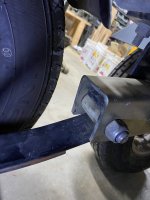My new to me pontoon trailer seems to not be set up right. I need some help figuring out what is off. With the trailer level, the equalizer is slanted forward about 15-25 degrees and the front axle tires appear to be bearing more weight than the rears based on the visual that the tires with the same psi are pooched out more than the rears.
Some notable points….has c hook slipper springs. even though the front tires are pooched out more, the rear part of the c hook on that axle does not seem to be bearing weight at the equalizer. i checked the weight distribution (with a bathroom scale so give it take) is about 7% at the tongue. The rear axle has been replaced. It is not exactly the same axle, same 2” tube, but the bearings smaller at least when looking at the hub. The hanger spacing is fixed on a single bracket so the pivot points are not adjustable. The rear axle appears to be canted a few degrees. Any ideas?
Some notable points….has c hook slipper springs. even though the front tires are pooched out more, the rear part of the c hook on that axle does not seem to be bearing weight at the equalizer. i checked the weight distribution (with a bathroom scale so give it take) is about 7% at the tongue. The rear axle has been replaced. It is not exactly the same axle, same 2” tube, but the bearings smaller at least when looking at the hub. The hanger spacing is fixed on a single bracket so the pivot points are not adjustable. The rear axle appears to be canted a few degrees. Any ideas?























